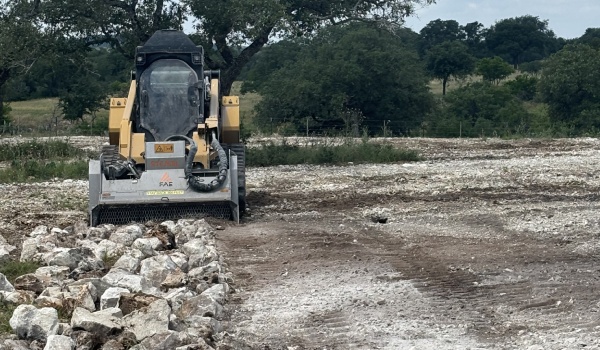Business
Rock Milling: The Game-Changer for Texas Land Development
Published
2 months agoon
By
Prime Star
Rock formations across Texas present one of the most persistent challenges in land development and construction projects. From the limestone bedrock of Central Texas to the sandstone layers of East Texas, these geological features can turn straightforward excavation into complex, expensive operations. Rock milling has emerged as the preferred solution, offering efficiency and precision that traditional methods simply cannot match.
Understanding why rock milling has become essential for Texas projects requires examining both the geological landscape and the economic pressures facing developers. The Lone Star State’s diverse rock formations demand specialized approaches that balance speed, cost-effectiveness, and environmental responsibility. Rock milling delivers on all three fronts, making it an indispensable tool for modern land clearing operations.
The evolution from explosive demolition and hydraulic breaking to advanced milling techniques represents more than just technological progress—it reflects the industry’s response to stricter regulations, tighter budgets, and increased environmental awareness. Projects that once faced months of delays due to rock removal now maintain their timelines through strategic milling applications.
Why Traditional Rock Removal Falls Short
Conventional methods of rock removal have served the construction industry for decades, but their limitations become apparent when applied to large-scale Texas projects. Blasting, while effective for breaking apart massive formations, creates numerous complications that modern developers cannot ignore.
The permitting process for explosive removal can extend project timelines by weeks or months. Environmental impact assessments, noise ordinances, and safety protocols create bureaucratic hurdles that delay progress and inflate costs. Additionally, blasting produces unpredictable results, often creating debris that requires extensive cleanup and sorting.
Hydraulic breaking offers more control than explosives but lacks the efficiency needed for substantial rock removal projects. The process involves positioning heavy equipment to fracture rock systematically, which works well for smaller areas but becomes prohibitively time-consuming on larger sites. Equipment wear increases dramatically when processing harder materials, leading to frequent maintenance breaks and replacement costs.
These traditional approaches also struggle with precision. Creating specific grades or maintaining existing structures nearby becomes challenging when using methods designed for bulk removal rather than selective processing.
The Rock Milling Advantage
Rock milling transforms problematic geological features into manageable materials through mechanical grinding and pulverization. Specialized equipment equipped with carbide teeth or cutting heads systematically processes rock formations, reducing them to specified sizes for various applications.
The precision offered by modern milling equipment allows operators to target specific areas while preserving surrounding terrain. This selectivity proves invaluable when working around existing infrastructure, utilities, or environmental features that must remain undisturbed. Projects can proceed with confidence, knowing that milling operations will not compromise adjacent structures or create unintended damage.
Speed represents another significant advantage of rock milling. While traditional methods require extensive setup, safety preparations, and cleanup phases, milling equipment can begin processing immediately upon arrival. The continuous nature of the operation means steady progress throughout the workday, with minimal downtime between phases.
The processed material resulting from rock milling often proves more valuable than debris from conventional removal methods. Uniform sizing and consistent quality make milled rock suitable for various construction applications, from road base to drainage systems. This dual benefit of removal and material production enhances project economics significantly.
Applications Across Texas Industries
Agricultural operations throughout Texas increasingly rely on rock milling to expand usable acreage and improve field conditions. Shallow limestone outcroppings that prevent effective cultivation can be processed to create fertile planting areas. The milled material often serves as a soil amendment, improving drainage and mineral content for enhanced crop production.
Ranching operations benefit from rock milling when establishing pastures, constructing stock tanks, or building access roads. The ability to process rock in place eliminates the need for hauling away debris and importing fill material. This efficiency translates to substantial cost savings on large ranch development projects.
Commercial and residential development projects utilize rock milling to overcome geological challenges that would otherwise require expensive workarounds. Shopping centers, housing subdivisions, and industrial facilities can proceed on previously unsuitable sites through strategic milling applications.
Infrastructure projects, including highway construction, utility installation, and municipal improvements, rely heavily on rock milling capabilities. The Texas Department of Transportation has recognized the benefits of milling techniques for roadway preparation, particularly in areas where traditional excavation proves problematic.
Texas Land Clearing Solutions: Leading the Industry
Professional rock milling requires specialized equipment, experienced operators, and comprehensive project planning. Texas Land Clearing Solutions has established itself as the premier provider of rock milling services across the state, combining advanced machinery with decades of geological expertise.
The company’s fleet includes state-of-the-art milling equipment capable of processing various rock types and formations. From compact units suitable for residential projects to massive machines designed for commercial applications, Texas Land Clearing Solutions matches equipment specifications to project requirements for optimal results.
Operator expertise distinguishes professional milling services from generic excavation companies. Understanding rock composition, formation characteristics, and optimal processing techniques requires specialized training and experience. Texas Land Clearing Solutions invests heavily in operator development, ensuring each team member possesses the skills necessary for efficient, safe milling operations.
Project planning services provided by experienced professionals help clients understand the full scope of rock milling possibilities. Site assessment, geological analysis, and equipment selection contribute to project success while minimizing unexpected complications or delays.
Environmental and Economic Benefits
Rock milling offers significant environmental advantages over traditional removal methods. The elimination of explosives reduces noise pollution, air quality impacts, and vibration effects on nearby structures. Communities benefit from less disruptive construction practices that maintain quality of life during project execution.
Waste reduction represents another environmental benefit of rock milling. Rather than hauling away unwanted material to disposal sites, milling operations convert rock formations into useful products that remain on-site or serve other local projects. This approach reduces transportation requirements, fuel consumption, and disposal facility pressure.
Economic benefits extend beyond direct cost savings to include broader project impacts. Faster completion times reduce financing costs, labor expenses, and equipment rental fees. The ability to proceed with development on previously challenging sites expands opportunities for profitable projects that might otherwise remain unfeasible.
Property values often increase following professional rock milling operations. Land that was previously considered difficult or expensive to develop becomes attractive to buyers and investors. This value enhancement can justify milling expenses while providing long-term returns on investment.
Planning Your Next Project
Successful rock milling projects begin with thorough site evaluation and realistic timeline development. Understanding the type, depth, and extent of rock formations helps determine equipment requirements and processing strategies. Professional assessment services can identify potential challenges before they impact project schedules or budgets.
Permitting requirements for rock milling typically prove less complex than those for explosive removal, but local regulations still apply. Early consultation with regulatory agencies ensures compliance and prevents delays during the approval process.
Equipment selection depends on multiple factors, including rock hardness, project size, access limitations, and final product requirements. Professional milling services can recommend optimal approaches based on specific project parameters and budget considerations.
Transform Your Land Development Projects
Rock milling has revolutionized land development across Texas, turning geological obstacles into manageable challenges. The combination of precision, efficiency, and environmental responsibility makes this technology essential for modern construction projects. Whether addressing agricultural expansion, commercial development, or infrastructure improvement, rock milling provides solutions that traditional methods cannot match.
The expertise and equipment offered by Texas Land Clearing Solutions ensure that your next project benefits from the latest advances in rock processing technology. Professional milling services transform challenging sites into development-ready properties while maintaining budget constraints and environmental standards.

MegaCustom: Personal Gifts Made Beautiful

Design Something Special with MegaCustom

Top 10 SEO Agencies for Barber Shops

The Secret to Choosing Colours That Truly Work with Your Flooring

Why Vietnam Became the Traveler’s Favorite Destination

The Story of Elijah Judd: Wynonna Judd’s Son and His Private Journey

Who Is Susan Andrews? Inside the Private Life of Tucker Carlson’s Wife

Why Hiring AWS Developers is Key for Your Cloud Strategy in 2026

Balcony Power Plant Plug-in Solar:101 Guide

AI in Human Resources: Elevating Workforce Strategy Through Intelligence

Who Is Marlene Knaus? The Untold Story of Niki Lauda’s First Wife

Curious About JOI Database? Read This First Before You Click Anything

Jacqueline Bernice Mitchell: The Inspiring Story of Jerry Rice’s Ex-Wife

Should You Use Wooflix in 2025? Honest Review and Best Alternatives

Where Is Noelle Watters Now? Jesse Watters’ Ex-Wife’s Life After Divorce

Where Is Barbara Boothe Now? Inside Her Life After Larry Ellison

Alisande Ullman Today: What Happened After Her Divorce from Leslie Nielsen?

Where Is Tanya Hijazi Now?: All About Rick James’ Former Wife

Wendy Lang: Meet the Therapist Married to Cenk Uygur

Mickey Middleton: The Untold Story of Bryan Cranston’s First Wife

MegaCustom: Personal Gifts Made Beautiful

Design Something Special with MegaCustom

Top 10 SEO Agencies for Barber Shops

The Secret to Choosing Colours That Truly Work with Your Flooring

Why Vietnam Became the Traveler’s Favorite Destination

The Story of Elijah Judd: Wynonna Judd’s Son and His Private Journey

Who Is Susan Andrews? Inside the Private Life of Tucker Carlson’s Wife

Why Hiring AWS Developers is Key for Your Cloud Strategy in 2026

Balcony Power Plant Plug-in Solar:101 Guide

AI in Human Resources: Elevating Workforce Strategy Through Intelligence
Categories
Trending
-

 Celebrity6 months ago
Celebrity6 months agoWho Is Marlene Knaus? The Untold Story of Niki Lauda’s First Wife
-

 Entertainment5 months ago
Entertainment5 months agoCurious About JOI Database? Read This First Before You Click Anything
-

 Celebrity3 months ago
Celebrity3 months agoJacqueline Bernice Mitchell: The Inspiring Story of Jerry Rice’s Ex-Wife
-

 Entertainment5 months ago
Entertainment5 months agoShould You Use Wooflix in 2025? Honest Review and Best Alternatives
